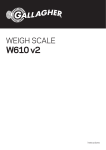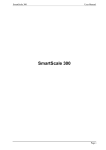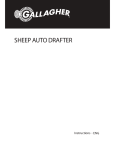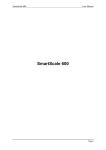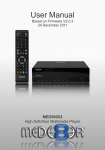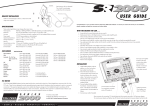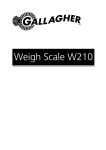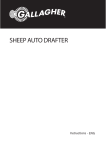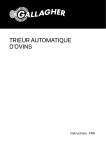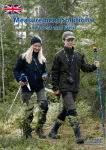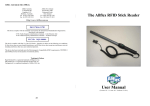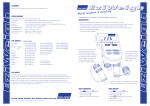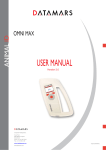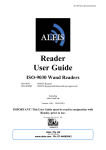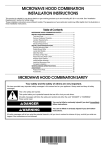Download SmartScale 700 - Rudd Products
Transcript
SmartScale 700 User Manual SmartScale 700 Page i User Manual SmartScale 700 PUBLISHED BY Gallagher Group Limited Kahikatea Drive, Private Bag 3026 Hamilton, New Zealand Copyright© Gallagher Group Limited 2007. All rights reserved. Patents Pending. SmartScale 700 User Manual 3E1134 - Edition 5.4 - July 2007 DISCLAIMER Whilst every effort has been made to ensure accuracy, neither Gallagher Group Limited nor any employee of the company, shall be liable on any ground whatsoever to any party in respect of decisions or actions they may make as a result of using this information. In accordance with the Gallagher policy of continuing development, design and specifications are subject to change without notice. Developed and manufactured by Gallagher Group Limited, an ISO 9001:2000 Certified Supplier. Page ii SmartScale 700 User Manual Table of contents Introduction................................................................................................................. 1 Care and maintenance ............................................................................................... 2 First-time use ....................................................................................................... 2 Installation................................................................................................................... 3 Installing the Scale bracket .................................................................................. 3 Installing the loadbars .......................................................................................... 4 Installing the Scale ............................................................................................... 4 Power and batteries ................................................................................................... 5 The Scale's controls................................................................................................... 8 Setup .......................................................................................................................... 10 Selecting a setup option..................................................................................... 11 Draft menu ......................................................................................................... 12 Session menu .................................................................................................... 16 Set the time and date......................................................................................... 20 User options ....................................................................................................... 21 Communications ................................................................................................ 23 Select a country ................................................................................................. 26 Using Electronic IDs................................................................................................. 27 Cross-referencing Visual Tag Numbers............................................................. 27 Sessions .................................................................................................................... 30 Sessions overview ............................................................................................. 30 Session naming formats .................................................................................... 32 Storage capacity ................................................................................................ 33 Session statistics................................................................................................ 33 Selecting a view ................................................................................................. 34 Statistics screen ................................................................................................. 34 Weight gain screen ............................................................................................ 37 Weight records screen ....................................................................................... 38 Carcass weight screen....................................................................................... 40 Recording animal information without weighing.................................................. 41 Automatic storing of Electronic IDs.................................................................... 41 Assigning Visual Tag Numbers to Electronic IDs .............................................. 42 Recording standard animal information ............................................................. 43 Recording animal traits ...................................................................................... 44 Preparing to weigh ................................................................................................... 45 Weighing modes ................................................................................................ 45 Scale layout........................................................................................................ 47 Connecting the Scale to the loadbars................................................................ 48 Setting the tag prefix .......................................................................................... 48 Page iii User Manual SmartScale 700 Weighing in a standard session ............................................................................. 49 Creating a new standard weighing session ....................................................... 49 Procedure for weighing animals in a standard session ..................................... 50 Procedure for weighing static loads standard.................................................... 54 At the end of the weighing session .................................................................... 55 Drafting by weight .............................................................................................. 55 Weighing in a trait session ...................................................................................... 56 Creating a new trait weighing session ............................................................... 56 Procedure for weighing animals in a trait session ............................................. 57 Procedure for weighing static trait loads............................................................ 61 At the end of the weighing session .................................................................... 61 Weighing while drafting by list................................................................................ 62 What is a Draft List?........................................................................................... 62 Setting up the Draft List ..................................................................................... 63 Connecting the equipment ................................................................................. 64 Selecting the Draft List and setting gates .......................................................... 65 Procedure for weighing and drafting animals .................................................... 66 Drafting by list without weighing ........................................................................ 70 At the end of the weighing session .................................................................... 71 Editing weight records............................................................................................. 72 About editing weight records.............................................................................. 72 Editing a weight record from a standard or draft list session............................. 73 Deleting a weight record in the current session................................................. 74 Checking for duplicate Visual Tag Numbers......................................................... 75 Editing a duplicate Visual Tag Number.............................................................. 76 Accepting duplicate Visual Tag Numbers .......................................................... 76 Updating the Cross-Reference Table with Tag Checking ................................. 77 Additional features ................................................................................................... 78 Memory full warning ........................................................................................... 78 Weight-on-scale memory ................................................................................... 78 Zero tracking ...................................................................................................... 79 Printing ............................................................................................................... 80 Interfacing software: MyScale Pro.......................................................................... 82 Loadbar and platform options................................................................................. 83 Gallagher Standard Loadbars............................................................................ 83 Gallagher Heavy Duty Loadbars........................................................................ 84 Gallagher Super Heavy Duty Loadbars ............................................................. 84 Gallagher Suspension Load Cell 250 kg ........................................................... 85 Gallagher Suspension Load Cell 500 kg ........................................................... 85 Specifications ........................................................................................................... 86 SmartScale 700 Dimensions.............................................................................. 86 General .............................................................................................................. 86 Weight increments ............................................................................................. 87 Page iv SmartScale 700 User Manual Introduction Thank you for purchasing the SmartScale 700. Gallagher has been making agricultural weighing equipment for over 60 years. In that time we have earned a reputation for the manufacture of quality equipment that is simple, tough, innovative and reliable. The SmartScale range of Scales is specifically designed to accurately weigh live animals. However the Gallagher range is also well suited to weighing static loads and can be used for this purpose in industrial applications. As well as weighing, SmartScale 700 includes the following features; • You can type animal management information in plain text using the QWERTY keyboard. • You can identify animals using Electronic IDs and/or Visual Tag Numbers. • You can record a condition score or note for each animal, or up to eight animal traits. • You can use graphs as an aid to analysing changes in animal weight over time. • You can draft up to nine ways either by weight or from a list. • You can view session statistics, analysed by draft group. Page 1 User Manual SmartScale 700 Care and maintenance The SmartScale 700 is a tough and reliable product designed for use in typical livestock environments. However proper care and maintenance can extend its life. Listed below are guidelines for keeping the SmartScale Scale in good condition. • Don't submerge the Scale in any liquid. • Store the Scale in a cool, dry place. Avoid storing it in direct sunlight. • After use, clean the Scale with a damp cloth. Take care not to scratch the display. • Fit the connector caps to keep the connections clean and dry. First-time use When you open the Scale the first time, you will find that the display screen is covered with a transparent overlay. The overlay is printed with the number 630 and other characters. Remove this overlay before starting to use the Scale. The overlay is easily removed after first grasping the tab. Page 2 SmartScale 700 User Manual Installation Installing the Scale bracket The bracket can be mounted on a flat vertical surface, or on a round post. To mount the bracket on a flat vertical surface, for example a square post or board, use the outer holes. To mount the bracket on a round post, use the inner holes. Don't mount the Scale bracket on the weighing crate or chute. Page 3 User Manual SmartScale 700 Installing the loadbars To install the loadbars, follow these steps: Note: Fit the loadbars as per the manufacturer's instructions. 1. Bolt the platform to the loadbars. 2. Ensure the platform is placed on a flat and level surface. Make sure it is not touching any rails or gates. 3. Either bolt the loadbars to the concrete pad or locate them on studs set into the concrete. This will prevent the platform from moving during the weighing session. 4. Connect the loadbar cables to the Scale. Note: If you are using non Gallagher loadbars ensure the loadbars are correctly calibrated. Installing the Scale The Scale can be placed on a table top or mounted on the Scale bracket supplied. Position the Scale: Page 4 • clear of the platform to ensure it does not interfere with the flow of animals during the weighing cycle • within easy reach of the loadbar leads • within easy reach of the operator (for manual weighing) • in a well-lit area SmartScale 700 User Manual Power and batteries During a weighing session, the Scale can be powered by its internal battery alone or by its internal battery and either the battery charger or an external 12 volt battery. The battery charger connects between an AC outlet and the Scale. If either the battery charger or an external 12 volt battery is connected to the Scale, the Scale's internal battery will be charged while the Scale is in use. For optimum performance, switch off the Scale and charge its internal battery for at least five hours. When fully charged, the internal battery on its own will power the Scale continuously for a minimum of eight hours. Battery life may be reduced if the Scale is being used to power an Electronic ID reader. Charging the battery The battery in the Scale can be recharged using either a battery charger or an external 12 volt battery. Recharging the battery will take up to five hours depending on the level of charge already in the battery. The Scale can be in use or can be switched off while the battery is being charged. Page 5 User Manual SmartScale 700 Using the battery charger To charge the battery using the battery charger, follow these steps. 1. Connect the lead between the battery charger and the Scale. 2. Plug the battery charger into an AC outlet and switch on. 3. Open the Scale case and make sure the battery charge icon on the main screen is flashing. This indicates that the battery is charging and will be displayed whether the Scale is turned on or off. Using an external 12 volt battery To charge the Scale's internal battery using an external 12 volt battery, follow these steps. 1. Connect the supplied black and red battery leads to the Scale. 2. Connect the other end of the battery leads to the 12 volt battery. Connect the Red clip to the Positive terminal Connect the Black clip to the Negative terminal 3. Open the Scale case and make sure the battery charge icon on the main screen is flashing. This indicates that the battery is charging and will be displayed whether the Scale is turned on or off. Page 6 SmartScale 700 User Manual Battery charge status The battery icon displays in the bottom left corner of the Scale's upper screen. It is important to note that the battery icon will only ever show the actual amount of charge left in the battery when the Scale is turned on and disconnected from external power. Fully Charged Battery Icon bars are all displayed constantly. Partially Charged Battery Icon shows first four bars constantly. Battery Flat No Battery Icon bars are displayed. When the Scale is connected to the external power supply the battery icon will display the charging status. Charging Battery Icon shows all the bars constantly filling and then disappearing. Topping Up Battery Icon shows the first four bars constantly full and the remainder filling and then disappearing. Trickle Charge Battery Icon shows only one empty bar that is constantly travelling the length of the full Icon. Low battery warning When the charge remaining in the battery drops to a very low level, the Scale will beep and the battery charge icon will start to flash. At this stage, about 15 minutes remain before the Scale shuts down. Low voltage shutdown When the battery charge drops to a critical level, the Scale will shut down. At this stage it is necessary to recharge the battery. Page 7 User Manual SmartScale 700 The Scale's controls Soft Keys Five soft keys are arranged along the bottom of the lower screen. The function of these soft keys changes depending on what the lower screen displays. For any given screen, not all soft keys have a function. Those that do are labelled in the screen. Page 8 • Buttons like , and movement vertically up and down the screen. • and Buttons like horizontally across the screen. • The function of other buttons is described elsewhere in this user manual. allow allow movement SmartScale 700 User Manual The mode select switch The Scale can operate in three weighing modes and a setup mode. The mode select switch is located on the left hand side of the Scale. The mode select switch has five positions: , A, M, F and S. Immediately after you turn the switch to any position except , explanatory information will display on the lower of the two Scale screens. The explanatory information will display only for a few seconds; after it disappears, the screen displays information relevant to the selected option. This position turns the Scale off. A This position selects weighing in Automatic mode. You can also store Electronic IDs and update the Scale's crossreference table when there are no loadbars connected. M This position selects weighing in Manual mode. You can also record animal information, without weighing, when there are no loadbars connected. F This position selects weighing in Fine mode. It is designed for static-load weighing. Static-load weighing can occur in standard or trait sessions. S This position accesses the setup options. Page 9 User Manual SmartScale 700 Setup To access the Setup menu, turn the mode select switch to S. The setup menu displays on the lower of the two screens on the Scale. In setup mode, the main screen normally displays the time in 24 hour format. Every minute the main screen momentarily displays the date, then automatically reverts to displaying the time again. The setup menu contains six options: 1. DRAFT MENU - select the drafting mode and specify the drafting limit(s). 2. SESSION MENU - select a session and view, print or delete the session. 3. SET TIME AND DATE - set the current time and date. 4. USER OPTIONS - select weight units, turn Visual Tag Number checking on or off, turn live printing on or off. 5. COMMUNICATIONS - set up a connection to a computer, printer, Electronic ID reader or other external device and enable drafting via the auto Drafter. 6. SELECT COUNTRY - for a specific country, selects a language and country-specific terminology and weight unit. Page 10 SmartScale 700 User Manual Selecting a setup option When you turn the mode select switch to S, one of the setup menu options displays. To select an option from the Setup menu: or 1. Press the menu option. 2. Press soft key to display the required . Alternatively, using the keypad, you can press the number of the menu item that you want to select. For example: • to select the Session Menu, press 2, • to select Communications, press 5. For more information about each of the setup menu items, see the following sections. Page 11 User Manual SmartScale 700 Draft menu The Draft menu lets you set: • the drafting mode, • the drafting limits, and • the drafting gate number (if you have set up auto drafting). Drafting can be completed: • Manually For manual drafting the Scale displays the appropriate drafting gate to open. • Automatically Using an autodrafter. About drafters A drafter uses the weight of the animal or a Draft list (requiring EID tags on animals) on the Scale to determine which draft gate to open for the animal. For manual drafting the Scale displays the appropriate draft gate. For autodrafting the Scale sends the drafting gate number to the drafter controller which opens the correct gate or gates. Depending on the drafter used the Scale can control up to nine drafting gates. Page 12 SmartScale 700 User Manual Manual drafting To set up the Scale for manual drafting, complete the following: 1. Ensure that no port is set for drafting. For further details see Communications (p 23). 2. Set the required draft mode. a. Turn the mode selection switch to S. b. Select DRAFT MENU. The current mode displays at the top of the screen. c. Press the soft key until the required drafting mode is displayed. The drafting mode cycles between Drafting Off and Drafting from 2-way up to 9-way. 3. Set the required draft limits. soft key to select the draft limit you wish a. Press the to change. b. To change a gate number: Note: If no Drafter is enabled in the Communications menu, then gate numbers are not displayed. to delete the existing gate number. • Press • Use the keypad to enter the new gate number (0 to 9). c. To change a draft limit: • Press to delete the existing draft limit. • Use the keypad to enter the new draft limit. Note: Set up the draft limits so that the smallest is at the top and the largest is at the bottom. If you enter the draft limits out of . order, the Scale reorders them once you press d. Repeat steps for all required changes. 4. Press menu. to save the changes and return to the SET UP Page 13 User Manual SmartScale 700 Notes: • • • Page 14 On the 2 WAY DRAFTING screen, gate numbers are shown against the H Gates and L Gates labels. • H Gates sets the gate number for animals that weigh anything higher than the Draft Limit. • L Gates sets the gate number for animals that weigh the Draft Limit or anything lower than the Draft Limit. On the 3 WAY DRAFTING screen, gate numbers are shown against the H Gates, C Gates and L Gates labels. • H Gates sets the gate number for animals that weigh the Upper Limit or anything higher than the Upper Limit. • C Gates sets the gate number for animals that weigh the Lower Limit or anything higher than the Lower Limit and lower than the Upper Limit. • L Gates sets the gate number for animals that weigh anything lower than the Lower Limit. On the 4 WAY or more DRAFTING screen, gate numbers are shown as numbers, with gate 1 as the lowest limit. SmartScale 700 User Manual Automatic drafting To set up the Scale for auto drafting, complete the following: 1. Configure the connection between the Scale and the Drafter. For further details see Communications (p 23). 2. Select the required draft mode. a. Turn the mode selection switch to S. b. Select DRAFT MENU. The current mode displays at the top of the screen. c. Press the soft key until the required drafting mode is displayed. The drafting mode cycles between Drafting Off and Drafting from 2-way up to 9-way. 3. Set the required draft limits and gates. a. Press the soft key to select the draft limit you wish to change. b. To change a gate number: to delete the existing gate number. • Press • Use the keypad to enter the new gate number (0 to 9). c. To change a draft limit: to delete the existing draft limit. • Press • Use the keypad to enter the new draft limit. Note: Set up the draft limits so that the smallest is at the top and the largest is at the bottom. If you enter the draft limits out of . order, the Scale reorders them once you press d. Repeat steps for all required changes. 4. Press menu. to save the changes and return to the SET UP Page 15 User Manual SmartScale 700 Session menu The SESSION MENU lets you select and then view, print, rename or delete sessions. To display the Session Menu screen: 1. Turn the mode selection switch to S. 2. Select SESSION MENU. The following screen displays: The currently selected session displays in the title bar of the screen. and buttons to move between You can use the the options. Note: Depending on the type of session (Standard, Trait or Draft list) currently selected the soft keys displayed will change. Page 16 SmartScale 700 User Manual Selecting a session To select a particular session, complete the following steps: 1. Turn the mode selection switch to S. 2. Select SESSION MENU. 3. Press the SESSION. 4. Press or soft keys to highlight . A list of the stored sessions in the Scale displays. Each session is identified by the date the session was created and by the session name (if one was entered). If the session has no name, the time (using the 24 hour clock) the session was created displays (preceded by the "@" character). 5. Press the required session. 6. Press menu. or soft keys to highlight the to select the session and return to the Session Page 17 User Manual SmartScale 700 Renaming a session You can rename any of the standard sessions stored on the Scale from the Session menu. To rename a session, complete the following steps: 1. Select the session, as described in Selecting a Session. soft key. 2. Press the The existing session name displays on the screen. 3. Press the key to delete characters, as required. 4. Type in the new name, using the Scale keypad. The session name can contain up to 17 characters. to save the new session name and return to the 5. Press Session menu. The new session name is displayed in the title bar of the screen. Note: Draft List or Trait Sessions cannot be renamed. Viewing a session To view the details of a session, complete the following steps: 1. Select the session, as described in Selecting a Session (p 17). 2. Press the or soft keys to highlight VIEW. soft key. 3. Press the The details of the session display. and soft keys to scroll through the 4. Press the details of the session. The details include the Visual Tag Number, weight, condition score or any note entered for each record in a standard session. In a trait session, the condition score is not available and the traits are stored in the "Notes" column. In this view you cannot see the labels associated with each trait field. You can only see a list of the data you entered during the session. 5. Press to return to the Session menu. Note: You cannot edit the weight records from this view. See Editing weight records (p 72) if you want to edit records in the current weighing session. Page 18 SmartScale 700 User Manual Printing a session Make sure the SmartScale printer is connected to the Scale. To configure the port that the printer connects to on the Scale, see Communications (p 23) later in this section. 1. Select the session, see Selecting a Session (p 17). 2. Press the or soft key to highlight PRINT. 3. Press to print the session details and return to the Session menu. 4. Press to select the required printing order. 5. Press to print the session on the attached printer. Note: If a printer is not installed the Scale displays "No Printer Available". Deleting a session Note: Deleting a session removes it permanently from the Scale's memory. Before deleting a session it is recommended that you copy weighing sessions to your computer using the MyScale Pro software supplied with the Scale. Using MyScale Pro, you can restore the deleted session to the Scale, by copying it from the computer at a later date. See About MyScale Pro (p 82) for more information. 1. Select the session, see Selecting a Session (p 17). 2. Press the or soft keys to highlight DELETE. . 3. Press A screen displays asking you to confirm you want to delete the session. 4. Do you want to delete the session? • . If yes, press The session is deleted and the Session menu displays. • If no, press . The Session menu displays. The session is not deleted. Page 19 User Manual SmartScale 700 Set the time and date The SET TIME AND DATE screen lets you set the current time and date on the Scale's internal clock. The system time and date is recorded each time you create a new weighing session. You can view the current system time on the Scale's main screen when it is in Setup mode. Note: The date format changes depending on how the country options are set up, see Select a country (p 26). In New Zealand and Australia the date format used is DD-MM-YYYY. In the USA the date and time format is MM-DD-YYYY. In French Canada the date format used is YYYYMM-DD. The time must be entered in 24-hour format i.e. • 8:35 pm would be 20:35 • 8:35 am would be 08:35. To change the time or date, complete the following steps: 1. Turn the mode selection switch to S. 2. Select SET TIME AND DATE. The following screen displays. 3. Press the or soft keys to move to the digit that you want to change. The currently selected digit flashes. 4. Enter the new digit using the keypad. The flashing digit is replaced with the typed number and the cursor moves to the next digit. 5. Press to save the new time and date and return to the Setup menu. Note: The colon (:) that separates the hours from the minutes and the forward slash (/) that separates the day, month and year are not editable. Page 20 SmartScale 700 User Manual User options This screen enables you to see the following user options: • the weight unit to use when weighing animals. • tag checking • live printing To display the USER OPTIONS screen: 1. Turn the mode selection switch to S. 2. Select USER OPTIONS. Changing a user option To change a user option, complete the following steps: 1. Turn the mode selection switch to S. 2. Select USER OPTIONS. or 3. Press the you want to change. 4. Press soft keys to highlight the option to toggle between the available options. See the following sections for more information on each of the user options. 5. Press to save the changes and return to the Setup menu. Weight units You can specify whether the Scale uses kilograms (kg) or pounds (lb) for displaying and storing weights. Page 21 User Manual SmartScale 700 Live printing When Live Printing is turned on, the Scale prints the weight, tag number and condition score each time it locks onto a weight. Live Printing only occurs if you have connected the SmartScale printer to the Scale and set the port to Printer. See Communications (p 23). To print the weights at the end of the session, see Session menu (p 16). Note: This feature does not work with a standard computer printer, you need a SmartScale printer. Tag checking If Tag Checking is on, the Scale checks for duplicate Visual Tag Numbers. If a duplicate occurs within a weighing session, the Scale lets you edit either the current Visual Tag Number or the one that occurred earlier in the session. A duplicate Visual Tag Number can occur for any of the following reasons: • The same Visual Tag Number is entered twice during a session. • A Visual Tag Number is entered using the keypad and an Electronic ID is scanned that has the same Visual Tag Number assigned in the Scale's cross-reference table. • Two Electronic IDs are scanned and each has the same Visual Tag Number assigned in the Scale's cross-reference table. Note: The Scale checks for a duplicate Visual Tag Number, not a duplicate Electronic ID. This means duplicate Electronic IDs can occur in a session, provided that the Electronic ID does not have a Visual Tag Number linked to it in the Scale's cross-reference table. See Checking for Duplicate Visual Tag Number (p 75) for instructions on editing duplicate Visual Tag Numbers when they occur. Page 22 SmartScale 700 User Manual Communications The Communications menu enables you tell the Scale what device is connected to each port. The devices that can be connected to the Scale include a computer, printer, drafter or Electronic ID reader. Connections are made either to Port 1 or Port 2. The ports are located on the upper left hand edge of the Scale. Once you attach a device to a port, you must configure the port to suit. You do this from the Communications menu. To display the Communications menu, complete the following steps: 1. Turn the mode selection switch to S. 2. Select COMMUNICATIONS. The following screen displays: Page 23 User Manual SmartScale 700 Setting up a port To select the device to attach to the port, complete the following steps: 1. In the Communications menu, press the the port to which the device is connected. button to select 2. Press until the device that is attached to the port is displayed. Note: You cannot select a device for one port if it is already selected for the other. For example, you cannot select Computer on Port 2 if it is already selected on Port 1. Selections available for the ports are: Unused The port is unused (this is the default option). Computer Enables the connection of a computer. Used to copy weighing sessions to or from the computer. Printer Enables the connection of a Gallagher Printer. Used to print weighing session data either during or after the session. Data Logger Enables the connection of a data logger. Used to log weight records during a weighing session. EID Standard Enables the connection of a Gallagher/Standard Electronic ID stick reader with a set baud rate. See Using electronic tags (p 27). EID Destron Enables the connection of a Destron Electronic ID reader. EID Special Enables the connection of an Electronic ID reader with a selectable baud rate. Press to cycle through the options - 1200, 2400, 4800, 9600, 19200 bps - until the desired baud rate is displayed. Drafter Enables the connection of an auto drafter. Drafter Special Enables the connection of an auto drafter that requires its gates to be reset after each animal has been weighed. Enable the Drafter Fast option if you are connecting to an auto drafter that you want to operate in a fast mode. Page 24 SmartScale 700 User Manual Drafter Fast Enables the connection of an auto drafter that requires fast drafting, for example, the Racewell Automatic Sheep Crate. When operating an auto drafter in Drafter Fast mode, there is a slight decrease in the accuracy of weight measurements. Drafter Prattley Enables a Prattley Drafter to be controlled by the Scale. Ruddweigh Enables the connection of devices using the Ruddweigh protocol. Not available in some countries. (NZ/AU only) 3. Press to save the settings and return to the Setup menu. Autodrafter The Scale can interface directly with autodrafters. There are four options for communicating with the connected port; Drafter, Drafter Special, Drafter Fast and Drafter Prattley. The Scale sends drafting commands to the autodrafter during the weighing session. To connect an autodrafter with the Scale, complete the following steps: 1. Turn on the Scale. 2. Ensure the autodrafter is turned off. 3. Connect the autodrafter to one of the ports on the Scale. 4. Set the port to the required option, Drafter, Drafter Special, Drafter Fast or Drafter Prattley. See Communications (p 23) for more information. 5. Turn the autodrafter on. Note: For information about setting up the autodrafter into three-way drafting, see Draft menu (p 12). Page 25 User Manual SmartScale 700 Power feed to Electronic ID readers The Scale can supply power to an Electronic ID reader. Power is supplied only if the reader is connected to Port 2 and if any one of the three Electronic ID reader options is selected. With Port 2, if you nominate a device other than an Electronic ID reader, power feed is disabled. If the Electronic ID Reader you are using does not require power from the Scale, you can connect it to either Port 1 or Port 2. Select a country The Select Country menu lets you select the required country settings. The Scale country settings determine the following: • the language used with the screens and prompts; • some country-specific terminology; and • some default options. To display the Select Country menu, complete the following steps: 1. Turn the mode selection switch to S. 2. Select SELECT COUNTRY. The following screen displays: Changing the country To change the country, complete the following steps. 1. Press the country. or soft key to select the desired 2. Press to save the changes. IMPORTANT: Ensure that the country set on your Scale is the same as the country set in MyScale Pro. Page 26 SmartScale 700 User Manual Using Electronic IDs The Scale can be used with an electronic ear tagging system. During a weighing session an animal can be identified by reading its Electronic ID. You can use Electronic IDs on their own, or the Scale can also link and store the Visual Tag Number that identifies the same animal. The Visual Tag Number is whatever alpha numeric (up to nine characters) code that you choose to enter against an Electronic ID for a given animal. It might be based on the visible number printed on the ear tag or a combination of the number and the colour of the ear tag: "1234" or "123RED" etc. Setting up the Scale to use Electronic IDs The Electronic ID reader connects to one of the serial ports on the Scale. As described in Communications (p 23), this port must be set to read EID Standard. Cross-referencing Visual Tag Numbers The Scale maintains a cross-reference table that links an animal's Electronic ID with the animal's Visual Tag Number. Once it makes this link, the Scale remembers the Visual Tag Number the next time the Electronic ID is read. The Scale can store up to 6000 links between Electronic IDs and Visual Tag Numbers. If the limit is exceeded, new links between an Electronic ID and its Visual Tag Number cannot be stored. In this case, the next time the Electronic ID is read, its Visual Tag Number will not display. Warnings will appear leading up to this. See Memory full warning (p 78). Page 27 User Manual SmartScale 700 Linking an Electronic ID to its Visual Tag Number The first time you use an Electronic ID, follow these steps. 1. Read the animal's Electronic ID. You can read the Electronic ID before the animal steps on the platform or while the animal is on the platform. 2. The last four digits of the Electronic ID, preceded by a colon, display on the Scale's screen. 3. If you want to assign a Visual Tag Number to the Electronic ID, enter the number now, using the keypad. You must not enter the Visual Tag Number until the Electronic ID is displayed on the Scale's screen. The Visual Tag Number must also be entered before the animal leaves the platform. 4. After the animal has left the platform, the Electronic ID and Visual Tag Number will be linked together in the cross reference table in the Scale's memory. A record is also stored in the current session according to normal Scale behaviour. If you do not assign a Visual Tag Number, each time you read the Electronic ID in future, the last four digits of the Electronic ID, preceded by a colon, will display on the Scale's lower screen. Each time the Electronic ID is displayed you have the opportunity to enter, and link it to, a Visual Tag Number. Once you have linked an Electronic ID with a Visual Tag Number, only the Visual Tag Number will display on the Scale's screen each time the Electronic ID is read in a future weighing session. See Assigning Visual Tag Numbers to Electronic IDs. You can follow these steps during a weighing session or without having to weigh. In the latter case, you must use Manual mode with no loadbars connected. See Recording standard animal information (p 43). Page 28 SmartScale 700 User Manual Updating Incorrect Visual Tag Numbers in the CrossReference Table Once a link between an Electronic ID and its Visual Tag Number has been made, you can edit it if it is incorrect using one of the following methods: 1. Entering the correct Visual Tag Number and then reading the Electronic ID when in Automatic mode with no loadbars connected. See Assigning Visual Tag Numbers to Electronic IDs (p 42) for more detailed instructions. 2. Using MyScale Pro to update the cross-reference table. Refer to the MyScale Pro User Manual for detailed instructions. Page 29 User Manual SmartScale 700 Sessions A session is a collection of weight records for which the Scale displays statistics. Sessions have a start date but can remain open for a period of time. Each weighing event adds a record to the current session. To keep weight gain calculations accurate, it is recommended that you start a new session whenever you weigh a new group of animals. Each time data is collected a record is created. Sessions overview There are three types of sessions: Standard Session These sessions allow recording of standard animal information (note and condition score). Trait Session These sessions let you record up to eight traits for each animal. The traits that you can record in the session are defined in MyScale Pro and copied to the scale, prior to the session. Draft List Session These sessions let you draft animals according to their Electronic ID. The draft list is set up in MyScale Pro and copied to the Scale prior to the session. In addition to there being three types of session, the Scale also works in three different modes: Automatic, Manual and Fine. The other variable that affects the operation of the Scale is whether loadbars are connected. The Scale is able to perform different functions depending on the mix of these three variables. Those function capabilities are summarised in the following table: Page 30 SmartScale 700 User Manual Loadbars Connected Standard Session Automatic Mode Manual Mode Fine Mode • • • • Trait Session • • • Draft List Session • • • • Store Animal Weights Automatically Record Animal Information Draft by Weight Store Animal Weights Automatically Record Animal Traits Draft by weight Store Animal Weights Automatically Record Animal Information Draft by list • • • • • Store Animal Weights on Key Press Record Animal Information Draft by weight Store Animal Weights on Key Press Record Animal Traits Draft by weight Not used • • • Store Animal Weights on Key Press Record Information (two fields) Store Animal Weights on Key Press Record Information (eight fields) Not used No Loadbars Standard Session Automatic Mode Manual Mode Fine Mode • • Not Used • Trait Session • • Draft List Session Store Electronic IDs Update CrossReference Table Store Electronic IDs Update CrossReference Table Not recommended for use • • • • • Record Animal Information Update CrossReference Table Record Animal Traits Update CrossReference Table Draft by list Update CrossReference Table Not Used Not Used Page 31 User Manual SmartScale 700 Definitions Record Animal Information Condition Score, Notes as well as the animal's Electronic ID and Visual Tag Number. Record Animal Traits Up to eight fields, defined in MyScale Pro, as well as the animal's Electronic ID and Visual Tag Number. Session naming formats Each session file name has the following format: YYYY-MM-DD hh-mm NAME Where… YYYY Is the… 4 digit year Example… 2003 MM 2 digit month 06 DD 2 digit day 24 hh 2 digit hour in 24 hour format 13 mm 2 digit minutes 15 NAME Name of the weighing session that will display on the Scale. The name varies depending on session type, as below; STANDARD SESSION NAME The name can contain up to 17 STEERS characters and is chosen by the user. All letters will be upper case. Note: When the Scale creates an unnamed session file, the name is automatically set to --. Page 32 DRAFT LIST SESSION NAME When MyScale Pro creates a draft list Draft List session, the name is automatically set to Draft List. TRAIT SESSION NAME When the user creates a trait session, the Trait name will default to the Trait Table used Custom for the session and will contain upper and lower case letters. SmartScale 700 User Manual Examples of valid formats The following are examples of valid session file names. 2004-01-25 15-20 STEERS 2003-12-04 16-30 @1630 2004-03-16 11-20 Draft List 2004-03-16 11-20 Trait Mature Note: Although you didn't see the session start time on the Scale (unless the session has no user-entered name) it is always stored with the session. Storage capacity The information gathered each time the Scale makes a measurement is called a record. The Scale can store up to 16000 records. These include the records of all sessions including the current one. See Memory Full Warning (p 78). For information about the maximum number of cross references the Scale can store, see Cross-referencing Visual Tag Numbers (p 27). Session statistics The Scale gathers statistics as it weighs. Statistics can be presented in four ways: • a summary of weights. See Statistics screen (p 34). • a summary of weight-gains. See Weight gain screen (p 37). • a list of all the weights recorded. See Weight records screen. (p 38) • a summary of carcass weights. See Carcass weight screen (p 40). The Scale displays statistics of the current session in the lower screen. As weighing progresses, the statistics screen updates. Page 33 User Manual SmartScale 700 Selecting a view To select a different data view during a weighing session: 1. Turn the mode select switch to either A, M or F. 2. Press to cycle through the available screens. The data displayed on each of the screens is described in the following sections. Statistics screen The Weight Stats or Draft Stats screen displays summary weight data for animals in the current weighing session. The screen that is displayed depends on the weighing mode that you are using and whether drafting is turned on or off. Weight statistics The Weight Stats screens displays if: • drafting is switched off, or • you are weighing in fine mode. This Weight Stats screen shows the number, average, total, highest and lowest weights for all the animals in the current session. The left hand side of the lower screen displays information about the animal currently being weighed. Page 34 SmartScale 700 User Manual Draft statistics If drafting is turned on and you are in either automatic or manual weighing modes the Drafting Stats screen displays. The details on the lower screen change depending on the drafting mode selected. The screen shows the number, average and total weight of the animals in each drafting category as well as the gate through which the animal was drafted. The following screen shows the details for three way drafting. If you are drafting four ways or more, the statistics screen displays as shown. Pressing the button will allow you to scroll through the draft statistics for the other gates. If you are drafting by Draft List, the Statistics screen changes to: Page 35 User Manual SmartScale 700 Note: The soft key is only displayed if one of the Scale's ports is configured for a printer. For information on connecting a printer to the Scale see Communications (p 23). With a printer connected and configured you can print the statistics on this screen. Page 36 SmartScale 700 User Manual Weight gain screen The Weight gain screen shows weight gain data for the animal being weighed and weight gain statistics for all animals in the session. The weight gain graph on the left side of the screen shows the change in an animal's weight gain from one session to the next. The vertical axis represents weight gain, the horizontal axis represents time. Each point on the graph represents the weight gain (in kg/day) that occurred between two weighing sessions. For example, if the graph slopes upward, the rate of weight gain has increased. If the graph slopes downward the rate of weight gain has decreased. Note: Provided the weight gain figure is positive the animal has gained weight. The graph plots changes in weight gain not changes in weight. A downward slope in the line on the graph indicates a decrease in the rate of weight gain, not a decrease in actual weight. The weight gain (in kg/day) for the animal currently being weighed is displayed in the top left corner of the screen. This is also the last point on the graph. For example, in the screen shown above, the weight gain for the current animal and the last point on the graph is 1.09 kg/day. The graph shows that only one of four previous sessions has matched this weight gain. For the graph to be displayed: 1. There must be at least two previous sessions with a weight recorded for this animal (i.e. with the same tag number). 2. The sessions must have been created on different dates. The weight gain is calculated from the weight recorded in the most recent session for the same tag number. If there is no previous data for an animal, the screen displays "--.-" in place of the weight gain figure. Note: The session statistics (average, lowest and highest weight gain per day) displayed on this screen only include those animals for which weight comparisons can be made. The statistics do not include animals which are being weighed for the first time and therefore have no weight gain comparison. Page 37 User Manual SmartScale 700 Weight records screen Weight records screen for a standard or draft list sessions During a Standard or Draft list weighing session, the Weight Records screen shows the data recorded for each animal: • Visual Tag Number • Weight • Condition score • Notes and to scroll up or down the list and You can use view or edit other weight records in the current session. The last weight to be recorded is displayed at the top of the screen. This screen can also be used to edit the weight records in the current session. From further information, see Editing weight records (p 72). The Tag Count value represents the number of Electronic ID tags read when the loadbars are not connected. Page 38 SmartScale 700 User Manual Weight records screen for a Trait session During a trait session, the Weight Records screen shows the data recorded for each animal: • Visual Tag Number • Weight • Trait entries and to scroll up or down the list and You can use view other weight records in the current session. The last weight to be recorded is displayed at the top of the screen. This screen can also be used to edit a Visual Tag Number in the current session. For further information, see Editing a weight record from a Trait session. Page 39 User Manual SmartScale 700 Carcass weight screen The Carcass Weight screen displays the carcass weight of the animal. The carcass weight is calculated using the kill-out percentage that you enter. The carcass weight statistics are displayed on the right hand side of the screen. The format is the same as that used in the WEIGHT STATS or DRAFTING STATS screens. The carcass weights on the screen shown above are based on a kill-out percentage of 53%. Within each drafting category, the average and total carcass weights displayed will be 53% of the average and total weights recorded for the session. The number of animals in each drafting category is displayed. If drafting is turned off, the lowest and highest carcass weight is also displayed. Note: If the kill-out percentage is changed during the weighing session, the carcass weights are recalculated. Kill out percentage To change the kill-out percentage: . 1. Press The current kill-out percentage screen displays. to delete the current kill-out percentage. 2. Press one character is deleted. Each time you press 3. Enter the new kill-out percentage using the keypad. 4. Press to save the change and recalculate the carcass weights based on the new kill-out percentage. Page 40 SmartScale 700 User Manual Recording animal information without weighing The SmartScale 700 lets you record details about animals against animal tags (electronic or visual) without needing to record a weight. The information is added to the current session (Standard only) in the same way as a normal record, but with the weight set to zero. Note: Only records that contain a weight are added to the session statistics. Automatic storing of Electronic IDs You can use the Scale in a hands-free mode, to record the Electronic IDs for a group of animals. The Electronic IDs are stored in the current session. This can be used, for example, as a method of recording which animals arrived or left your farm on a particular day. In this case, it is recommended that you start a new standard session before storing the Electronic IDs. The procedure for storing Electronic IDs automatically is: 1. Make sure there are no loadbars connected to the SmartScale 700. 2. Turn the mode select switch to A. 3. Read each Electronic ID. Each Electronic ID is stored in a separate record in the current session. The weight is set to zero. The session statistics do not change. Note: If the Scale's cross-reference table already stores a Visual Tag Number linked to an Electronic ID you have read, the weight record on the Scale will display the Visual Tag Number, not the Electronic ID. When you copy the session to the computer, both the Electronic ID and Visual Tag Number will be visible. Page 41 User Manual SmartScale 700 Assigning Visual Tag Numbers to Electronic IDs In the current Scale session, you can assign a Visual Tag Number to an Electronic ID once. To change an assigned Visual Tag Number in the Scale's cross-reference table, you must transfer the cross-reference table to MyScale Pro. To assign a Visual Tag Number to an Electronic ID: 1. Make sure there are no loadbars connected to the SmartScale 700. 2. Turn the mode select switch to M. 3. Scan the Electronic ID. 4. Enter the Visual Tag Number using the keypad and press the green Weigh button. The Visual Tag Number you entered is now linked to the Electronic ID in the Scale's cross-reference table. A record is added to the current session containing the Visual Tag Number and with the weight set to zero. The session statistics are unchanged. For information on editing weight record in the current session, see Editing weight records (p 72). Generally, the Visual Tag Number is assigned to the Electronic ID • during the normal weighing process, or • via the tag bucket file. Note: Copying a Session file from the computer to the scale will always update the Cross Reference Table in the scale for any animals contained in that Session. This will be regardless of the date that the weighing Session was conducted. If multiple sessions are copied, the most recent session that each animal appeared in will be that animal's new record in the Scale's Cross Reference Table. Page 42 SmartScale 700 User Manual Recording standard animal information To store condition scores and notes about animals without recording a weight, follow these steps: 1. Make sure there are no loadbars connected to the SmartScale 700. 2. Turn the mode select switch to M. 3. Ensure you are in a standard session (not a trait session). If you are not, you will need to start a new standard session. See Creating a new standard weighing session (p 49). 4. If you are using Electronic IDs to identify the animal, scan the animal's Electronic ID. 5. Enter the animal's Visual Tag Number using the keypad, if it is not already displayed. Note: If you read an Electronic ID that was already linked to a Visual Tag Number in the Scale's cross-reference table, it will be displayed and you will not be able to edit it. 6. Press 7. Press keypad. and enter a one or two digit condition score. and enter the note (up to 13 characters) using the 8. Press the green Weigh button to save the record. A text record is added to the current session containing the information you entered and with the weight set to zero. The session statistics do not change. None of the fields are compulsory (Electronic ID, Visual Tag Number, Condition Score or Note), however, you must enter some information before the record is saved. Normally, you will want to identify the animal (using the Electronic ID or Visual Tag Number) before saving information about the animal using the condition score or note. Page 43 User Manual SmartScale 700 Recording animal traits The SmartScale 700 lets you record values against animal characteristics for a specific animal tag number (electronic or visual) without needing to record a weight. The information is added to the current session in the same way as a normal record, but with the weight set to zero. The traits against which you can record information for each animal are defined in MyScale Pro and copied to the Scale. When you start a new Trait session on the Scale the last trait table you copied to the Scale becomes permanently associated with that session. This defines the traits you can enter data against in this session. Refer to the MyScale Pro User Manual for more information. To store animal trait information without a weight, follow these steps: 1. Make sure there are no loadbars connected to the SmartScale 700. 2. Turn the mode select switch to M. 3. Ensure you are in a Trait session. If you are not you will need to start a new trait session. See Creating a new trait weighing session (p 56). 4. If you are using Electronic IDs, scan the animal's Electronic ID. If the Electronic ID is already linked to a Visual Tag Number in the Scale's cross-reference table, the Visual Tag Number displays briefly and is then replaced by the trait table. If the Electronic ID is not linked to a Visual Tag Number in the Scale's cross-reference table, you can enter one now (this is not compulsory). The Visual Tag Number, if you enter one, replaces the Electronic ID on the Scale's display. 5. If you are using Visual Tag Numbers only, enter it now. The Visual Tag Number is displayed as you enter it. to display it 6. If the trait table is not already displayed, press now. Enter the trait data using the keypad. The number of characters available for each is indicated by the blank underlines. 7. Press the green Weigh button to save the record. The animal information you entered is added to the current session as a new record with the weight set to zero. The session statistics do not change. Page 44 SmartScale 700 User Manual Preparing to weigh Weighing modes Automatic Automatic mode is recommended for yards that allow a smooth flow of animals across the weighing platform. In Automatic mode, the Scale automatically starts the weight measurement process as soon as the animal steps onto the platform. After the weight has been captured, the Scale beeps and displays the captured weight. The captured weight continues to display until the next animal steps onto the platform. After the animal leaves the platform, the Scale attempts to compensate for the weight of any accumulation of mud or dung left on the platform. If it succeeds, the Scale displays a zero icon. If it does not you can manually restore zero by pressing the blue zero button. Manual Manual mode is recommended for yards that do not allow a smooth flow of animals across the weighing platform or where the animals are restless. This mode allows the operator to decide when the measurement is made. In manual mode, the operator presses the green weigh button to start the weight measurement process. After the weight has been captured, the Scale beeps and displays the captured weight. The captured weight continues to display until the next animal steps onto the platform. After the animal leaves the platform, the Scale attempts to compensate for the weight of any accumulation of mud or dung left on the platform. If it succeeds, the Scale displays a zero icon. If it does not you can manually restore zero by pressing the blue zero button. Page 45 User Manual SmartScale 700 Fine Fine mode is recommended for weighing static loads such as fleeces or produce. In Fine mode, the Scale displays the weight on the platform in the same way as a bathroom scale. If a weight measurement is to be added to the session statistics, the operator presses the green weigh button. The weight is captured at this point, but it is not stored in the weight record until the weight is removed from the platform. After the weight has been captured, the statistics are updated. For information about statistics, see Session statistics (p 33). The displayed weight continues to reflect the actual weight on the platform. In Fine mode, automatic zero tracking is switched off. This means the Scale does not automatically compensate for the weight of objects left on the platform after the load has been removed. For more information, see Zero tracking (p 79). The blue zero button has a function in Fine mode if you want to make net-weight measurements of a load inside a container. For example, you could place an empty container on the weighing platform and press the blue zero button. If you then filled the container, the weight indication will be only that of the container's contents. Note: In Fine mode, after the blue zero button has been pressed, the weight icon does not display. indication shows zero but the Page 46 SmartScale 700 User Manual Scale layout Note: If you are using the Scale without connection to an external power source, ensure that the battery has been charged for at least five hours before use. Page 47 User Manual SmartScale 700 Connecting the Scale to the loadbars Before you begin the weighing session, complete the following steps: 1. Open the Scale case. 2. Mount the Scale on a flat surface or clip it onto the Scale bracket. 3. Ensure all required accessories are connected and setup, for example: • Loadbars • Drafters • Electronic ID readers 4. Determine if you require additional power for the Scale. Either connect to an AC outlet via the battery charger or connect to a 12 volt battery. If you are not connecting to an external power source, the Scale's internal battery should be fully charged. See Charging the Battery (p 5), if required. 5. Check and update the setup options, as required. See Setup (p 10) for further details. Setting the tag prefix Tag numbers can have common prefixes. Once you configure a tag number prefix on the Scale it is inserted at the start of any Visual Tag Number you enter during the session. To set the tag number prefix, complete the following steps. 1. Turn the mode select switch to A (Automatic) or M (Manual). 2. Press . 3. Type in the prefix, using the keypad. The prefix can contain up to four characters. 4. Press Page 48 to save the prefix. SmartScale 700 User Manual Weighing in a standard session Creating a new standard weighing session To create a new standard weighing session, complete the following steps: 1. Turn the mode select switch to A (Automatic) or M (Manual). 2. Press the soft key. The NEW SESSION screen displays: The options of Trait or Draft List show when there are such sessions present in the Scale: 3. Enter the required name for the session, using the keypad. The name can be up to 17 alpha-numeric characters long. key to delete characters. Press the Note: You can leave the session unnamed. 4. Press to save the new session. A statistics screen displays with all values set to zero. Page 49 User Manual SmartScale 700 Procedure for weighing animals in a standard session To weigh an animal in a standard session follow this procedure: 1. Select the weighing mode that you want to use by turning the mode select switch to A (automatic) or M (manual). When the Scale is switched on, the previous weighing session is still the current session. If you want you can create a new weighing session, see Creating a new standard weighing session (p 49) for more details. 2. If required, you can enter an ear tag prefix for the animals being weighed. See Setting the tag prefix (p 48) for further details. 3. Check that the icon is displayed. If it is not displayed, press the blue "zero" button to zero off any weight (e.g. dirt or manure) left on the platform. 4. Load the animal onto the platform. Ensure the animal is contained on the platform (e.g. no hooves off the platform and no one holding the animal). 5. If required, you can record the animal's Visual Tag Number or scan an Electronic ID. • Page 50 Using Electronic IDs: Scan the animal's Electronic ID. The Electronic ID can be scanned at any time before or while the animal is on the platform. If you are using Electronic ID numbers only, the last 4 digits of the tag number preceded by a colon (:) displays on screen. If you entered a Visual Tag Number the first time the Electronic ID was scanned, the Visual Tag Number displays on screen. If this is the first time you have scanned the Electronic ID and you want to enter an associated Visual Tag Number, you can enter it now. In future, each time you scan the Electronic ID, the associated Visual Tag Number will display on screen. See Using Electronic IDs (p 27) for further details. SmartScale 700 User Manual • Using Visual Tag Numbers: Use the keypad to enter the Visual Tag Number. Up to nine characters, alphabetic or numeric, can be entered. to If an incorrect Visual Tag Number is entered, press delete each incorrect character. Re-enter the correct tag number. The Visual Tag Number can be entered at any time before or while the animal is on the platform. When the Visual Tag Number is entered, the date and any note entered, the last time the animal was weighed displays on the screen. 6. If required, you can store information about the animal being weighed using the "Condition Score" and "Notes" fields. Refer to the following table for instructions on entering a condition score or note. You can enter this information before the animal steps onto the platform (i.e. when the platform is empty) or while the animal is on the platform. Field What can be stored How to use Condition Score One or two digits Press the button on the keypad and type the score. Notes Up to 13 characters, Press the button on alphabetic or the keypad and type the note. numeric. If an incorrect entry is made, press to delete each incorrect character and then re-enter the correct information. 7. Follow the instructions for the weighing mode you have selected. • Automatic Mode When the Scale has determined an accurate weight for the animal, it locks on to the weight and holds it on the screen. The time taken to lock on to the weight varies depending on the movement of the animal. Manual Mode Press the green weigh button to start weighing the animal. When the Scale has determined an accurate weight for the animal, it locks on to the weight and holds it on the screen. The time taken to lock on to the weight varies depending on the movement of the animal. Page 51 User Manual SmartScale 700 8. When the Scale has locked onto the weight: • the "Weight OK" light illuminates; • displays on the screen; • the Scale beeps; If drafting is turned on, the gate number displays indicating the drafting category. The statistics screen updates immediately. The weight screen does not update until the animal has left the platform. 9. If the weight has locked on but you want to re-weigh the animal, press the green weigh key. The Scale re-weighs the animal and locks onto the weight again. The new weight replaces the original weight and the statistics are updated. For example, if the animal was not completely on the weighing platform, the Scale may have locked onto an incorrect weight. You do not need to re-enter the Visual Tag Number, condition score or note if you have re-weighed the animal. 10. Move the animal off the platform. The weight of the animal is recorded as soon as the animal leaves the platform (the weight decreases by 30% or more). At this point the record saves. To further edit the Notes and Condition Scores you have to use the process outlined in Editing weight records (p 72). The weight remains on the screen until the next animal steps onto the platform. If the animal has left the platform and you want to delete the weight that has just been recorded, press the red delete button. The last weight entered will be deleted from the Scale's memory and the following screen will display. Page 52 SmartScale 700 User Manual 11. The Scale automatically zero's off any weight left on the platform icon is (e.g. dirt or manure). When this has occurred the displayed on the screen. icon does not display, press the blue zero button. If the The Scale does not need to return to zero before the next animal is loaded onto the platform. Once the weight has dropped by 30%, the display will unlock ready for the next animal to be loaded onto the platform. This is a useful feature when weighing sheep. 12. Repeat the process from step 4 until all animals are weighed. Page 53 User Manual SmartScale 700 Procedure for weighing static loads standard 1. Turn the mode select switch to F (Fine mode). 2. Follow the procedure outlined in Creating a new standard weighing session (p 49). 3. Ensure that the displayed weight is zero. To zero the scales, press the blue Zero button. Note: The icon is not displayed in Fine mode. 4. Place the load onto the platform. 5. If you want to store information, enter desired values into the "Tag Number", "Condition Score" and "Notes" fields. For example, you may want to enter a wool bale reference number or a note to identify specific bales. Refer to the following table to select the field that you want to use. You can enter this information before the load is placed on the platform (i.e. when the platform is empty) or while the load is on the platform. Field What can be stored Tag number Up to nine (Reference characters, number) alphabetic or numeric. How to use Use the keypad to enter the reference number. Condition score One or two digits. Press the button on the keypad and type the score. Notes Up to 13 characters, Press the button on the alphabetic or keypad and type the note. numeric. 6. Press the green Weigh button, to record the weight. The statistics screen updates immediately. The weight screen does not update until the load is removed from the platform. 7. Move the load off the platform. The weight screen updates. 8. Repeat the procedure from Step 3 for subsequent items to be weighed. Page 54 SmartScale 700 User Manual At the end of the weighing session 1. Switch the Scale off by turning the mode select switch to the position. 2. Disconnect the loadbar cables. 3. Fit the protective caps to the loadbar cables. 4. Fit the protective caps to the Scale. Drafting by weight To draft animals by weight you need to set up the following: 1. Connect the loadbar to the Scale. See Connecting the Scale to the loadbar (p 48). 2. Connect the Drafter to the Scale and set up the correct communications for the Drafter. See Communications (p 23). 3. Set up drafting limits on the Scale. See Draft menu (p 12). 4. Create a standard session. See Creating a new standard weighing session (p 49). 5. Weigh and draft the animals. Page 55 User Manual SmartScale 700 Weighing in a trait session Trait sessions allow you to record details of individual animals by entering values against various characteristics. Trait tables define which traits can be recorded in a session and the maximum number of characters in each. Trait tables are created in MyScale Pro and copied to the Scale. When you start a trait session, it uses the trait table that was last sent to the Scale. You can customise the traits recorded or use breeder society values. Refer to the MyScale Pro User Manual for further information. Creating a new trait weighing session To create a new trait session there must first be a trait table present in the Scale. This must be copied from your computer using the MyScale Pro (version 2.1.0 or later) program. To create a new trait session, follow this procedure; 1. Turn the mode select switch to A (Automatic) or M (Manual). 2. Press the displays. soft key. The NEW SESSION screen soft key. The session name is automatically 3. Press the designated and cannot be changed. 4. Press to save the new session. A statistics screen displays with all values set to zero. The previous session is stored in the Scale's memory and can be viewed using the Session menu. See Session menu (p 16). Page 56 SmartScale 700 User Manual Procedure for weighing animals in a trait session To weigh an animal in a trait session follow this procedure: 1. Select the weighing mode that you want to use by turning the mode select switch to A (automatic) or M (manual). When the Scale is switched on, the previous weighing session is still the current session. If you want you can create a new Trait session, see Creating a new trait weighing session (p 56). 2. If required, you can enter an ear tag prefix for the animals being weighed. See Setting the tag prefix (p 48) for further details. 3. Check that the icon is displayed. If it is not displayed, press the blue "zero" button to zero off any weight (e.g. dirt or manure) left on the platform. 4. Load the animal onto the platform. Ensure the animal is contained on the platform (e.g. no hooves off the platform and no one holding the animal). 5. If required, you can record the animal's Visual Tag Number or scan an Electronic ID. • Using Electronic IDs: Scan the animal's Electronic ID. The Electronic ID can be scanned at any time before or while the animal is on the platform. If you are using Electronic ID numbers only, the last 4 digits of the tag number preceded by a colon (:) displays on screen. If you entered a Visual Tag Number the first time the Electronic ID was scanned, the Visual Tag Number displays on screen. If this is the first time you have scanned the Electronic ID and you want to enter an associated Visual Tag Number, you can enter it now. In future, each time you scan the Electronic ID, the associated Visual Tag Number will display on screen. See Using Electronic IDs (p 27) for further details. Page 57 User Manual SmartScale 700 • Using Visual Tag Numbers: Use the keypad to enter the Visual Tag Number. Up to nine characters, alphabetic or numeric, can be entered. to If an incorrect Visual Tag Number is entered, press delete each incorrect character. Re-enter the correct tag number. The Visual Tag Number can be entered at any time before or while the animal is on the platform. When the Visual Tag Number is entered, the date and any note entered, the last time the animal was weighed displays on the screen. 6. If the trait table is not already displayed, press the display it. key to Note: The animal's Electronic ID or Visual Tag Number displays in the top left corner of the trait table. The weight gain, if one can be calculated for this animal, displays in the top right corner of the trait table. 7. The cursor flashes in the field adjacent to the first trait label. The number of characters able to be entered against each label is indicated by the blank underlines. Use the arrow soft keys to navigate between the traits and enter the values for this animal. key alternates the display between Note: Pressing the the Visual Tag Number entry screen and the trait table. You cannot return to the statistics or weight record screens until the weight is removed from the Scale. Page 58 SmartScale 700 User Manual 8. Follow the instructions for the weighing mode you have selected. • • Automatic Mode When the Scale has determined an accurate weight for the animal, it locks on to the weight and holds it on the screen. The time taken to lock on to the weight varies depending on the movement of the animal. Manual Mode Press the green weigh button to start weighing the animal. When the Scale has determined an accurate weight for the animal, it locks on to the weight and holds it on the screen. The time taken to lock on to the weight varies depending on the movement of the animal. 9. When the Scale has locked onto the weight: • the "Weight OK" light illuminates; • displays on the screen; • the Scale beeps; If drafting is turned on, the gate number displays indicating the drafting category. The statistics screen updates immediately. The weight screen does not update until the animal has left the platform. 10. If the weight has locked on but you want to re-weigh the animal, press the green weigh key. The Scale re-weighs the animal and locks onto the weight again. The new weight replaces the original weight and the statistics are updated. For example, if the animal was not completely on the weighing platform, the Scale may have locked onto an incorrect weight. You do not need to re-enter the Visual Tag Number, condition score or note if you have re-weighed the animal. Page 59 User Manual SmartScale 700 11. Move the animal off the platform. The weight of the animal and the traits will be recorded as soon as the animal leaves the platform (the weight decreases by 30% or more). The weight record screen displays the details of the record just created. If the animal has left the platform and you want to delete the weight that has just been recorded, press the red delete button. The last weight record, including the traits, will be deleted from the Scale's memory and the statistics updated. The following screen displays. The key has no function in a trait session. 12. The Scale automatically zero's off any weight left on the platform (e.g. dirt or manure). When this has occurred the icon is displayed on the screen. If the icon does not display, press the blue zero button. The Scale does not need to return to zero before the next animal is loaded onto the platform. Once the weight has dropped by 30%, the display will unlock ready for the next animal to be loaded onto the platform. This is a useful feature when weighing sheep. 13. Repeat the process from step 4 until all animals are weighed. . Page 60 SmartScale 700 User Manual Procedure for weighing static trait loads 1. Turn the mode select switch to F (Fine mode). 2. Follow the procedure outlined in Creating a new trait weighing session (p 56). 3. Ensure that the displayed weight is zero. To zero the Scales, press the blue Zero button. Note: The icon is not displayed in Fine mode. 4. Place the load onto the platform. 5. To record trait values, press to display the trait table. Note: The trait fields that are displayed depend on the trait table configuration you have copied to the Scale from MyScale Pro. 6. Enter the values into the "Trait" fields adjacent to the relevant labels. 7. Press the green Weigh button, to record the weight. The statistics screen updates immediately. The weight screen does not update until the load is removed from the weighing platform . 8. Remove the load from the platform. The weight screen updates. 9. Repeat the procedure from Step 3, for subsequent items to be weighed. At the end of the weighing session 1. Switch the Scale off by turning the mode select switch to the position. 2. Disconnect the loadbar cables. 3. Fit the protective caps to the loadbar cables. 4. Fit the protective caps to the Scale. Page 61 User Manual SmartScale 700 Weighing while drafting by list What is a Draft List? The Draft List enables farmers to identify, using its Electronic ID, a specific group of animals to be drafted off during a session. A Draft List is a session file created on the computer with a particular naming format that identifies it when it is copied to the Scale. During a Draft List session you can: • weigh and draft animals, or • only draft animals. The results of the Draft List session are recorded in the Draft List. The Draft List can be copied to and from the Scale using MyScale Pro. Page 62 SmartScale 700 User Manual Setting up the Draft List The Draft List is created on the computer and copied to the Scale using MyScale Pro. Refer to the MyScale Pro User Manual for instructions on creating the Draft List and copying it to the Scale. When a Draft List is copied to the Scale it replaces any Draft List that already exists on the Scale. After you have completed your Draft List session you can copy the Draft List back to the computer for analysis or to update data in your farm management software program. Drafting groups and drafting gates: At the time you prepare a Draft List in MyScale Pro, you do not need to know which of the drafter's gates will be available for your purpose. When you prepare the list, you simply assign animals to groups. After you copy the Draft List to the Scale, you decide which drafting group will pass through which drafter gate. Outsiders: Outsiders are animals which: • are not on the list; • have no group number assigned to them in the list; or • have no Electronic ID. If an outsider passes through the drafter, the Scale assigns the animal to a special group called Others. When you select a Draft List session, the Scale gives you the opportunity to assign a drafter gate specifically to the Others group. Notes: • If you draft by list without weighing, you cannot draft animals that are not wearing Electronic ID tags. If you encounter such an animal, plan on having to manually shift it out of the drafter. • If you are weighing as you draft by list and you encounter an animal not wearing an Electronic ID tag, the Scale will draft the animal through the gate you assigned to the Others group. In this case, as the Scale cannot record an Electronic ID, you should add additional animal information, at least the animal's Visual Tag Number. Page 63 User Manual SmartScale 700 Connecting the equipment Before you begin a draft list session follow these steps: 1. Connect the automatic drafter to Port 1 on the Scale. 2. Connect the Electronic ID reader to Port 2 on the Scale. 3. Ensure Tag Checking is turned OFF. See Tag checking (p 22). 4. Set up both ports. See Communications (p 23). Ensure the following options are selected: Port 1 : Drafter Port 2 : EID Standard, EID Destron or EID Special 5. Ensure you have selected the draft list and set the gates for drafting. See Selecting the Draft List and setting gates (p 65). Page 64 SmartScale 700 User Manual Selecting the Draft List and setting gates To select a Draft List session, complete the following steps: 1. Turn the mode select switch to A (Automatic) if loadbars are connected or M (Manual) if you are not weighing. 2. Press the soft key. The NEW SESSION screen displays. soft key. 3. Press the The draft list screen displays. 4. Press . Note: The session name cannot be changed. 5. Set the required gates for each displayed draft group. or soft keys to select the required Press the draft group. Use the keypad to set the required gate number(s). to save the Draft list session details. 6. Press Note: You do not need to change the draft limit, as it is not used during a draft list session. Page 65 User Manual SmartScale 700 Procedure for weighing and drafting animals This section of the manual outlines the procedure to follow to weigh animals and draft them by list. You can also enter a note or condition score for each animal. 1. Select the weighing mode that you want to use by turning the mode select switch to A (Automatic) if loadbars are connected or M (Manual) if you are not weighing. When the Scale is switched on, the previous weighing session will still be the current session. See Selecting the Draft List and setting gates (p 65). 2. If required, you can enter an ear tag prefix for the animals being weighed. See Setting the tag prefix (p 48) for further details. icon is displayed. If it is not displayed, press 3. Check that the the blue "zero" button to zero off any weight (e.g. dirt or manure) left on the platform. 4. Load the animal onto the platform. Ensure the animal is contained on the platform (e.g. no hooves off the platform and no one holding the animal). 5. Scan the animal's Electronic ID. The Electronic ID can be scanned at any time before or while the animal is on the platform. If you are using Electronic ID numbers only, the last 4 digits of the tag number preceded by a colon (:) displays on screen. If you entered a Visual Tag Number the first time the Electronic ID was scanned, the Visual Tag Number displays on screen. If this is the first time you have scanned the Electronic ID and you want to enter an associated Visual Tag Number, you can enter it now. In future, each time you scan the Electronic ID, the associated Visual Tag Number will display on screen. 6. As soon as the Electronic ID has been read: • the gate number displays next to the weight (upper screen). • the date and any note entered the last time the animal was weighed is displayed on the screen. Page 66 SmartScale 700 User Manual 7. If you want to record a Note for this animal, press the key. The cursor displays and you can enter notes between the > < symbols. You can enter up to 13 characters. 8. If you want to record a Condition Score for this animal, press the key. You can enter a 1 or 2 digit value. and the keys enable you to Note: Both the switch between either of the values that you have entered. 9. When the Scale has determined an accurate weight for the animal, it locks on to the weight and holds it on the screen. 10. The time taken to lock on to the weight varies depending on the movement of the animal. 11. When the Scale has locked onto the weight: • the "Weight OK" light illuminates; displays on the screen; • • the Scale beeps; The statistics screen updates immediately. The weight screen does not update until the animal has left the platform. The weight remains on the screen until the next animal steps onto the platform; Page 67 User Manual SmartScale 700 12. Drafting by list, the statistics update in the following way: When an animal on the draft list is seen, the Actual Total column (Act Total) will increase by 1 and the Expected Total (Exp Total) column will decrease by 1. If the animal was not on the draft list the Actual Total column increases by 1, but the Expected Total column does not change. The same occurs for the Actual (Act) or Expected (Exp) totals for the draft group the animal belongs to. Note: The Exp Total column records the total number of animals on the draft list that are yet to be seen. 13. If the weight has locked on but you want to re-weigh the animal, press the green weigh key. The Scale re-weighs the animal and locks onto the weight again. The new weight replaces the original weight and the statistics are updated. For example, if the animal was not completely on the weighing platform, the Scale may have locked onto an incorrect weight. You do not need to re-enter the Visual Tag Number, condition score or note if you have re-weighed the animal. Page 68 SmartScale 700 User Manual 14. Move the animal off the platform. The weight of the animal is recorded as soon as the animal leaves the platform (the weight decreases by 30% or more). At this point the record saves. To further edit the Notes and Condition Scores you have to use the process outlined in Editing weight records (p 72). The weight remains on the screen until the next animal steps onto the platform. If the animal has left the platform and you want to delete the weight that has just been recorded, press the red delete button. The last weight entered will be deleted from the Scale's memory and the following screen will display. 15. The Scale automatically zero's off any weight left on the platform icon is (e.g. dirt or manure). When this has occurred the displayed on the screen. If the icon does not display, press the blue zero button. The Scale does not need to return to zero before the next animal is loaded onto the platform. Once the weight has dropped by 30%, the display will unlock ready for the next animal to be loaded onto the platform. This is a useful feature when weighing sheep. 16. Repeat the process from step 4 until all animals are weighed. Page 69 User Manual SmartScale 700 Drafting by list without weighing To draft animals by list, without weighing, follow these steps: 1. Disconnect loadbars. Turn the mode select switch to M (Manual). 2. Scan the animal's Electronic ID. After the animal's Electronic ID has been read the draft gate is displayed on the main Scale screen. If you have an automated drafter connected and configured, the designated gate will open. Although it is not visible on the Scale, the session records the fact that this animal was drafted. The draft result for each animal can be viewed in MyScale Pro, once the session has been copied back to the computer. When drafting by list the statistics update in the following way. When an animal on the draft list is seen, the Actual Total column (Act Total) will increase by 1 and the Expected Total (Exp Total) column will decrease by 1. If the animal was not on the draft list the Actual Total column increases by 1, but the Expected Total column does not change. The same occurs for the Actual (Act) or Expected (Exp) totals for the draft group the animal belongs to. Note: The Exp Total column records the total number of animals on the draft list that are yet to be seen. 3. Repeat Step 2 for each subsequent animal that you want to draft. Page 70 SmartScale 700 User Manual At the end of the weighing session 1. Switch the Scale off by turning the mode select switch to the position. 2. Disconnect the loadbar cables. 3. Fit the protective caps to the loadbar cables. 4. Fit the protective caps to the Scale. Page 71 User Manual SmartScale 700 Editing weight records About editing weight records Page 72 • Only records in the current session can be edited on the Scale. To edit records in other sessions you need to copy them to the computer. Refer to the MyScale Pro User Manual for more information. • The Tag Number, Condition Score and Notes can be edited during or after a standard session. • Trait table data can only be edited in MyScale Pro (Version 2.1.0 or later) when the session has been copied to the computer. One exception to this is that you are able to edit a Visual Tag Number where no Electronic ID is linked. • Weights cannot be edited. • Weight records cannot be edited while viewing the session in setup mode. SmartScale 700 User Manual Editing a weight record from a standard or draft list session In a standard or draft list session; 1. Turn the mode select switch to A or M. Note: You must have loadbars connected to edit the weight records in the current session. 2. Press displayed. 3. Use until the screen listing the individual weights is or to select the record to be edited. 4. Press the key once, to edit the record. Two asterisks ** displays in the top left corner of the screen when you are in edit mode. Note: Moving to a new row automatically cancels edit mode. 5. Press to cycle through the Tag Number, Condition Score and Note columns. to delete the 6. After you have selected a field to edit, press selected tag number, condition score or note. one character is deleted. Each time you press 7. Use the keypad to enter the new tag number, condition score or note. 8. Press to save the changes and exit edit mode. 9. Repeat this procedure from Step 3 to edit another record. Page 73 User Manual SmartScale 700 Deleting a weight record in the current session 1. Turn the mode select switch to A, M or F. 2. Press displayed. 3. Use until the screen listing the individual weights is or to select the record to be deleted. key once. Two asterisks ** display in the top left 4. Press the corner of the screen indicating you are in edit mode. 5. Press the red Delete button. The selected record is deleted from the session and the statistics are updated. 6. Repeat the procedure from Step 3 if you want to delete another record. Page 74 SmartScale 700 User Manual Checking for duplicate Visual Tag Numbers The Scale lets you check for duplicate Visual Tag Numbers during a weighing session. Duplicates can occur if the same animal is weighed twice in a session. They can also occur because a Visual Tag Number has been entered incorrectly. In this case, you can edit the incorrect Visual Tag Number immediately. For instructions on turning Tag Checking on and information about when a duplicate can occur, see User options (p 21). If a Visual Tag Number duplicate occurs within a session, a screen similar to the following displays. The duplicate Visual Tag Number is displayed and the Scale beeps three times. This duplicate tag screen enables you to: • accept both Visual Tag Numbers (i.e. the duplicate remains), or • edit the Visual Tag Number just entered, or • edit the Visual Tag Number recorded earlier in the session. Notes: • If you do not make a selection before the animal leaves the platform the duplicate Visual Tag Numbers remain. • Some Electronic ID readers can be set up so that they are unable to read the same Electronic ID twice in a session. If you want to use the Scale's tag checking feature to prevent an animal being weighed more than once in a session, you need to set up the reader so that it can read the same Electronic ID more than once. • To prevent multiple recordings of an Electronic ID, the Scale records the number once after the first reading. It will not record this Electronic ID again until after a different Electronic ID has been read. Page 75 User Manual SmartScale 700 Editing a duplicate Visual Tag Number If a duplicate Visual Tag Number occurs, the following screen will be displayed and the Scale will beep three times. This screen lets you change the current Visual Tag Number or the Visual Tag Number that was entered earlier in the session. To change the current Visual Tag Number: to delete the Visual Tag Number. If the 1. Use the backspace key Visual Tag Number is linked with an Electronic ID, pressing deletes the entire number. If the Visual Tag Number isn't linked with an Electronic ID, pressing deletes one digit. 2. Use the keypad to enter a new Visual Tag Number. To change the Visual Tag Number that was entered earlier in the session: 1. Press the button. 2. Use the backspace key to delete the Visual Tag Number. If the Visual Tag Number is linked with an Electronic ID, pressing deletes the entire number. If the Visual Tag Number isn't linked deletes one digit. with an Electronic ID, pressing 3. Use the keypad to enter a new Visual Tag Number. Accepting duplicate Visual Tag Numbers If you do not want to change either of the duplicate Visual Tag Numbers, press the button. The lower screen will display the Visual Tag Number just entered and you can continue with the usual weighing process. In this case, two records in the current session will contain the same Visual Tag Number. Page 76 SmartScale 700 User Manual Updating the Cross-Reference Table with Tag Checking When a duplicate tag number occurs and you change a Visual Tag Number that is already linked to an Electronic ID, the cross-reference table in the Scale, as well as the current session, is automatically updated. For more information about the Scale's cross-reference table or about linking a Visual Tag Number to an Electronic ID, see Using Electronic ID (p 27). The following procedure provides an example of how duplicate tag number checking can be used to update the Scale's cross-reference table: 1. In different sessions you read two Electronic IDs. By mistake you assign both the same Visual Tag Number of 500. The crossreference table in the Scale records this information as shown below. Electronic ID Visual Tag Number 90000000555 500 90000000444 500 2. You start a new session and read the first Electronic ID (90000000555). Later in the session you read the second Electronic ID (90000000444). The duplicate tag number screen displays with the Visual Tag Number 500 displayed. 3. You realise the Visual Tag Number linked with Electronic ID 90000000444 should be 600 not 500. soft key to delete the 500 To correct the mistake, you press the and use the keypad to enter the correct Visual Tag Number of 600. When the animal leaves the platform the current session and the cross-reference table are automatically updated. The crossreference table now records the information shown below. Electronic ID Visual Tag Number 90000000555 500 90000000444 600 Page 77 User Manual SmartScale 700 Additional features Memory full warning The Scale can store up to 16000 records. This is a total of 16000 records across all weighing sessions, not just the current session. When the record tally is 1000 records short of the limit, the Scale beeps and a memory full warning displays. The warning displays again 50 short of the limit accompanied by three beeps. When the record tally is only 20 short of the limit, the warning displays and three beeps sound each time a new record is added. When the record tally reaches 16000, the Scale beeps four times and will not accept any more records. To continue weighing, switch the Scale to Set Up mode and use the Session Menu screen to select and delete a previous session. Before deleting a session, you can also copy the weighing sessions to a computer, so that you can keep a record of the data. Refer to the MyScale Pro User Manual, for more information. Weight-on-scale memory The Scale remembers the weight on the display at the time it is switched off. This weight is restored if the same weight is on the platform at the time the Scale is switched back on. For example, if you are using Fine mode to weigh wool in a bale on a wool press, you can part-fill the bale and then turn the Scale off at the end of the day. Provided the load is still on the Scale, this weight is remembered when you return the following day and switch the it back on. As you add to the bale, the weight increases from the remembered weight at the end of the previous day. Page 78 SmartScale 700 User Manual Zero tracking As animals pass through the weighing crate, an accumulation of mud and dung may build up on the weighing platform. The Scale can compensate for the weight of this accumulation by subtracting it from the total weight. The automatic subtraction of the residual weight from the total weight is called zero tracking. Zero tracking ensures that the Scale captures the animal's weight and not the mess left on the platform. The way zero tracking is initiated depends on the weighing mode. Automatic and manual modes In the Automatic and Manual weighing modes, zero tracking is automatically implemented if, after the animal leaves the weighing platform, the residual weight is within a defined zero tracking range. • If the residual weight is within the defined range, the icon displays. • If the residual weight is outside the defined range, the icon does not display. To manually compensate for the residue, press the blue zero button. The icon displays. During a weighing session, if the Scale consistently does not restore to zero, check that there are no obstructions under or around the platform or crate. Fine mode In the Fine weighing mode, automatic zero tracking is disabled. The icon does not display in the Fine weighing mode. Page 79 User Manual SmartScale 700 Printing A SmartScale printer can be attached to the SmartScale 700. If the SmartScale printer is connected during a weighing session, you can configure the Scale to print each animal's tag number, weight and condition score when the Scale locks on to the weight. The SmartScale printer has its own internal rechargeable battery. The battery can be recharged using the battery charger supplied with the printer. For instructions on printing weights at the end of the weighing session, or from a previous session, see Session menu (p 16). Note: The SmartScale 700 is only compatible with a SmartScale printer. Printing weights during a weighing session To print each weight record during a weighing session, follow these steps. 1. Connect the printer cable to one of the two serial ports on the Scale. 2. Turn the mode select switch to S to display the setup menu. 3. Select 5. COMMUNICATIONS. Ensure the port to which the printer is connected is set to Printer. When the Scale case is open, Port 1 is on the top, left side of the Scale. Port 2 is directly below. 4. Press to return to the setup menu. 5. Select 4. USER OPTIONS on the setup menu. Page 80 SmartScale 700 User Manual 6. Ensure LIVE PRINTING is turned ON. Each time the Scale locks on to a weight, the following information prints. • Visual tag number, or if none exists, the last four digits of the Electronic ID number preceded by a colon. • Weight. • Condition score. • the drafting gate, if drafting is turned on. Note: If in a trait session, trait information will not print and there will be no condition score. Page 81 User Manual SmartScale 700 Interfacing software: MyScale Pro MyScale Pro is software that can be run on a personal computer. After a connection has been made between the computer and the Scale, MyScale Pro can process information obtained from the Scale. With MyScale Pro you can: • retrieve sessions from the Scale. • copy sessions to the Scale. • edit sessions. • edit Electronic ID and Visual Tag Number links. • prepare Draft lists. • prepare trait tables. • copy trait tables to the Scale. • prepare session statistics more advanced than those displayed by the Scale itself. • view animal weight-gain graphs across sessions. • email sessions to selected recipients. • change Scale setup • create reports. Detailed instructions are contained in the MyScale Pro User Manual. Page 82 SmartScale 700 User Manual Loadbar and platform options It is recommended that you use Gallagher Loadbars with the SmartScale 700 Scale. The SmartScale 700 Scale recognises most commonly available Loadbar sets. To connect to some Loadbar sets, adapter cables may be required. If you are not using Gallagher Loadbars, a calibration check will be required prior to first use. Gallagher Standard Loadbars Features • 2000 kg weighing capacity - Available in 600mm (23") and 1000mm (39") lengths • Tough rugged steel loadbars • Bottom feet mounting holes extend beyond top covers for ease of bolting down • Slotted top mounting holes fit all sizes of platforms and crushes • 6m (20') long tough loadbar cables fitted with high quality connectors • Fully waterproof • No rubber mounts Talk to your Gallagher dealer about the best platform and/or crate for your requirements. Page 83 User Manual SmartScale 700 Gallagher Heavy Duty Loadbars Features • 3500 kg weighing capacity • 1000 mm (39") rugged steel loadbars • Bottom feet mounting holes extend beyond top covers for ease of bolting down • 6 m (20') long tough loadbar cables fitted with high quality connectors • Fully waterproof • No rubber mounts • High capacity load cells withstand large shock loads • Heavy steel chassis construction absorbs the harshest of impacts • Set them and forget them for permanent installation under large crushes. Talk to your Gallagher dealer about the best platform and/or crate for your requirements. Gallagher Super Heavy Duty Loadbars Features • 4500 kg weighing capacity • 1000 mm (39") rugged steel loadbars • Bottom feet mounting holes extend beyond top covers for ease of bolting down • 6 m (20') long tough loadbar cables fitted with high quality connectors • Fully waterproof • No rubber mounts • High capacity load cells withstand large shock loads • Heavy steel chassis construction absorbs the harshest of impacts • Set them and forget them for permanent installation under the largest crushes Talk to your Gallagher dealer about the best platform and/or crate for your requirements. Page 84 SmartScale 700 User Manual Gallagher Suspension Load Cell 250 kg Features: • 250 kg capacity loadcells • Replaces mechanical scale for hanging crates • Compact sturdy design • No rubber to delaminate or rot • Spiral spring metal reinforced cable • High quality moisture proof connectors Gallagher Suspension Load Cell 500 kg Features: • 500 kg capacity loadcells • Replaces mechanical scale for hanging crates • Compact sturdy design • No rubber to delaminate or rot • Spiral spring metal reinforced cable • High quality moisture proof connectors Page 85 User Manual SmartScale 700 Specifications SmartScale 700 Dimensions Metric Imperial Length 232 mm 9.25" Width 212 mm 8.5" Height 90 mm 3.5" Weight 2 kg 4.4 lb General Operating Temperature -20º to 50º C -5º to 120º F Page 86 Accuracy ± 1% Environmental protection rating IP67 SmartScale 700 User Manual Weight increments For Gallagher Loadbar sets, the weight increments are preset as shown in the table. For other loadbar sets talk to your Gallagher dealer. Weight Range Gallagher Standard Loadbars (2000 kg) Gallagher Heavy Duty and Super Heavy Duty Loadbars (3500 kg or 4500 kg) Automatic or Manual modes: 0 - 49.9 kg 200 g increments 500 g increments 50 - 199.9 kg 500 g increments 500 g increments 200 - 499.9 kg 1 kg increments 1 kg increments 500 - 1999.9 kg 2 kg increments 2 kg increments 2000 - 4999.9 kg Not Applicable 5 kg increments Fine mode: 0 - 49.9 kg 100 g increments 200 g increments 50 - 199.9 kg 500 g increments 500 g increments 200 - 199.9 kg 1 kg increments 1 kg increments 500 - 1999.9 kg 2 kg increments 2 kg increments 2000 - 4999.9 kg Not Applicable 5 kg increments Page 87 ONE YEAR WARRANTY REGISTER ONLINE AT www.gallagherams.com TO EXTEND YOUR WARRANTY TO TWO YEARS FOR THIS PRODUCT FROM DATE OF PURCHASE SELLING DEALER STAMP MODEL ......................................................................................... SERIAL NO ......................................................................................... DATE PURCHASED ......................................................................................... This product is guaranteed free from defects in material or workmanship for a period of one year from date of purchase by the end user. Gallagher will repair or replace at their option any faulty product returned to them or their Dealer within this time period. Freight/forwarding costs incurred by the Customer in the warranty process remain the responsibility of the Customer. damages or losses of any kind sustained directly or indirectly, a result of failure or defect in any product, material, installation or service. This warranty does not cover damage (including subsequent corrosive damage) due to: EUROPE AUSTRALIA Gallagher Australia Pty Ltd, 14 Somerton Park Drive, Campbellfield, Melbourne, Victoria, 3061 Gallagher Europe Bv, Hekkum 9, 9774 TH, Adorp (Gn), Netherlands Unauthorised repairs Modifications Failure to follow care and maintenance guidelines described in the User Manual Physical Mishandling Gallagher Power Fence Systems (IRL), Kinsale Road, Cork Lightning Strike NEW ZEALAND Floods, fires or acts of God Use of an arc welder on loadbars or equipment or steelwork attached to loadbars while a WeighScale is connected Gallagher, their Distributors, and their Dealers accept no responsibility for the misuse of this product. Gallagher, their Distributors, and their Dealers accept no responsibility for any accident caused subsequently to any tampering with or modification to or for the misuse of this product. Gallagher, their Distributors, and their Dealers accept no liability for consequences and/or secondary IRELAND Gallagher Animal Management Systems, 181 Kahikatea Drive, Private Bag 3026, Hamilton 3240 SOUTH AFRICA Rudd Products, Bush Willows, 24 Begonia Road, Kyalami Agricultural Holdings Kyalami, Johannesburg, Gauteng, 1684 USA / CANADA Gallagher USA Inc, 130 W 23rd Avenue, North Kansas City, MO 64116 Missouri PLEASE READ INSTRUCTIONS CAREFULLY BEFORE USE. PLEASE COMPLETE DETAILS AND KEEP WITH YOUR RECEIPT — IT IS YOUR PROOF OF WARRANTY





























































































